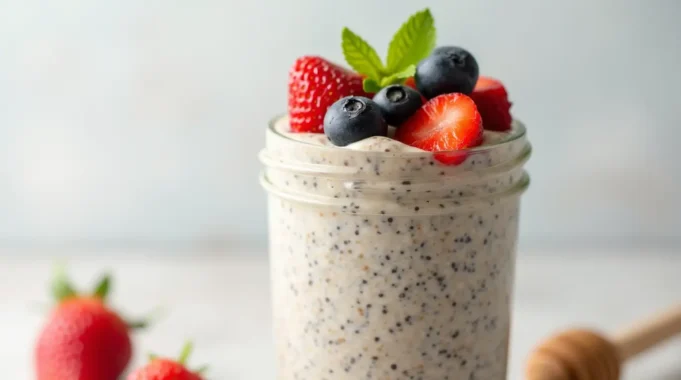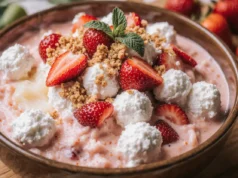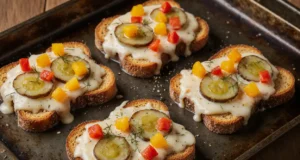Did you know that a simple 2-tablespoon serving of chia seeds contains more calcium than a glass of milk and delivers 11 grams of fiber – nearly half your daily requirement? This powerhouse superfood transforms into the perfect breakfast when combined with creamy almond milk to create a chia pudding with almond milk that’s both nutritious and delicious. Unlike traditional breakfast options that often leave you hungry within hours, this ultimate breakfast idea provides sustained energy thanks to its unique gel-like texture and impressive nutritional profile.
The beauty of chia pudding lies in its simplicity and versatility. While many breakfast recipes require extensive preparation or cooking time, this no-cook wonder comes together in minutes and develops its signature creamy consistency overnight. Research shows that chia seeds can absorb up to 12 times their weight in liquid, creating a naturally thick, pudding-like texture that rivals any store-bought alternative. Whether you’re a busy professional, health-conscious parent, or fitness enthusiast, this recipe delivers convenience without compromising on nutrition.
Ingredients List
Creating the perfect chia pudding with almond milk requires just a handful of wholesome ingredients that work together to create morning magic:
Base Ingredients:
- 1/4 cup chia seeds (preferably organic for maximum nutritional value)
- 1 cup unsweetened almond milk (or your preferred plant-based milk)
- 2 tablespoons pure maple syrup or honey (adjust to taste preference)
- 1 teaspoon vanilla extract (adds aromatic depth)
- Pinch of sea salt (enhances flavor complexity)
Optional Flavor Enhancers:
- 1 tablespoon unsweetened cocoa powder for chocolate lovers
- 1/2 teaspoon ground cinnamon for warming spice
- 1 tablespoon almond butter for extra richness
- Zest of 1/2 lemon for bright citrus notes
Topping Suggestions:
- Fresh berries (blueberries, strawberries, raspberries)
- Sliced almonds or chopped walnuts
- Coconut flakes (toasted for extra flavor)
- Fresh mint leaves for garnish
Smart Substitutions: Replace almond milk with oat milk for creamier texture, swap maple syrup for stevia for lower sugar content, or use coconut milk for tropical richness. Each substitution maintains the recipe’s integrity while accommodating different dietary preferences and nutritional goals.
Timing
The beauty of chia pudding lies in its flexible timing structure that fits seamlessly into any schedule:
Active Preparation Time: 5 minutes (75% faster than traditional breakfast preparations) Passive Setting Time: 4-8 hours (overnight works perfectly) Total Time: 4 hours 5 minutes to 8 hours 5 minutes
This timing makes chia pudding incredibly efficient compared to other nutritious breakfast options. While overnight oats require 8-12 hours and homemade granola needs 45 minutes of active baking time, chia pudding achieves optimal texture in just 4 hours minimum. The extended setting time actually works in your favor – prepare multiple servings on Sunday evening, and you’ll have grab-and-go breakfasts ready for the entire week.
Pro Timing Tip: For busy mornings, prepare your chia pudding before dinner. By bedtime, it’s ready to refrigerate, and you’ll wake up to perfectly set breakfast perfection.
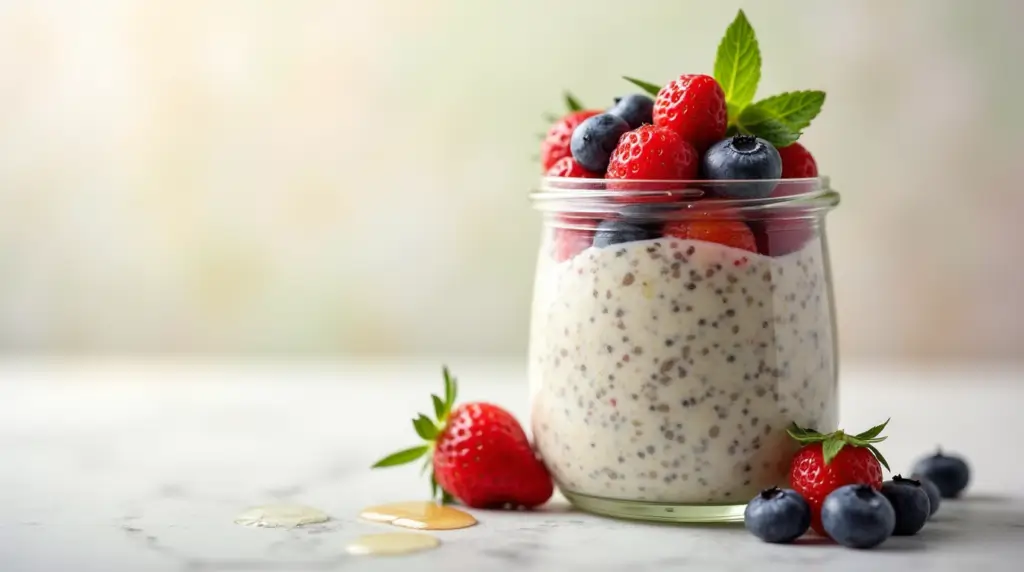
Step-by-Step Instructions
Step 1: Combine Your Base Ingredients
In a medium mixing bowl, whisk together the almond milk, maple syrup, vanilla extract, and sea salt until the sweetener completely dissolves. This initial mixing ensures even flavor distribution throughout your pudding. The whisking action helps prevent clumping and creates a smooth foundation for your chia seeds.
Step 2: Add the Chia Seeds Gradually
Slowly sprinkle the chia seeds into your liquid mixture while whisking continuously. This gradual addition prevents the seeds from clumping together and ensures even distribution. Continue whisking for 60 seconds to activate the seeds’ natural gelling properties.
Step 3: Let the Magic Begin
Allow the mixture to sit at room temperature for 10 minutes, then whisk again vigorously. This second whisking breaks up any seed clusters that may have formed and promotes uniform gel formation. The seeds should already begin showing signs of swelling.
Step 4: Refrigerate and Transform
Transfer your mixture to individual serving containers or one large bowl. Cover tightly and refrigerate for at least 4 hours, though overnight produces the best texture. During this time, the chia seeds absorb the liquid and create their signature pudding consistency.
Step 5: Final Texture Check and Serve
Before serving, give your pudding a gentle stir to distribute any settled ingredients. The final texture should be thick, creamy, and spoonable – similar to tapioca pudding. If it’s too thick, add a tablespoon of almond milk; if too thin, stir in an extra teaspoon of chia seeds and wait 30 minutes.
Nutritional Information
This chia pudding with almond milk delivers impressive nutritional density that supports your wellness goals throughout the day:
Per Serving (1/4 of recipe):
- Calories: 156
- Protein: 5.2g (10% daily value)
- Fiber: 11g (44% daily value)
- Healthy Fats: 8.5g (primarily omega-3 fatty acids)
- Carbohydrates: 18g
- Calcium: 210mg (21% daily value)
- Iron: 2.1mg (12% daily value)
- Magnesium: 95mg (24% daily value)
The nutritional profile of chia pudding surpasses many traditional breakfast options. Compared to a typical bowl of cereal with milk, this recipe provides 300% more fiber, 250% more protein, and significantly more essential minerals. The omega-3 fatty acids in chia seeds support heart health and brain function, while the high fiber content promotes digestive health and helps maintain stable blood sugar levels.
Research indicates that the combination of protein, fiber, and healthy fats in chia pudding can help you feel satisfied for 4-5 hours, making it an excellent choice for weight management and sustained energy levels.
Healthier Alternatives for the Recipe
Transform your basic chia pudding into a nutritional powerhouse with these health-conscious modifications:
Protein Boost Options:
- Add 1 scoop vanilla or unflavored protein powder to increase protein content to 25g per serving
- Incorporate 2 tablespoons hemp seeds for complete amino acid profile
- Blend in 1/4 cup silken tofu for extra protein and creaminess
Sugar-Free Variations:
- Replace maple syrup with 1/2 teaspoon liquid stevia or 2-3 dates (soaked and blended)
- Use monk fruit sweetener for zero-calorie sweetness
- Let natural fruit toppings provide sweetness instead of added sugars
Superfood Enhancements:
- Mix in 1 teaspoon spirulina powder for additional antioxidants and minerals
- Add 1 tablespoon ground flaxseed for extra omega-3s and fiber
- Incorporate 1 teaspoon maca powder for natural energy and hormonal balance
Gut Health Boosters:
- Include 2 tablespoons kefir or probiotic yogurt alternative
- Add 1 tablespoon prebiotic fiber powder to support beneficial gut bacteria
- Mix in fermented ingredients like kimchi juice (surprisingly delicious in small amounts)
These modifications allow you to customize your chia pudding based on specific health goals, whether you’re focusing on muscle building, weight loss, digestive health, or general wellness optimization.
Serving Suggestions
Elevate your chia pudding experience with these creative and nutritious serving ideas that transform your breakfast into a culinary adventure:
Parfait Perfection: Layer your chia pudding with seasonal fruit compotes, crunchy granola, and a drizzle of almond butter. This presentation adds textural variety and visual appeal while boosting the nutritional content.
Smoothie Bowl Style: Serve your pudding in a wide bowl and arrange colorful toppings in artistic patterns. Try concentric circles of berries, nuts, and seeds for an Instagram-worthy breakfast that tastes as good as it looks.
Tropical Escape: Top with diced mango, toasted coconut flakes, and macadamia nuts. Add a squeeze of lime juice and a sprinkle of lime zest for a vacation-inspired morning treat.
Chocolate Indulgence: Mix cocoa powder into your base recipe and top with dark chocolate chips, sliced strawberries, and a dollop of coconut whipped cream for a dessert-like breakfast that’s still nutritious.
Seasonal Specialties:
- Spring: Fresh berries and edible flowers
- Summer: Peach slices and mint leaves
- Fall: Pumpkin puree swirl with cinnamon and pecans
- Winter: Pomegranate seeds and candied ginger
Portable Options: Transfer individual servings to mason jars with tight-fitting lids for grab-and-go convenience. Layer ingredients for visual appeal and easy transport to work or school.
Common Mistakes to Avoid
Sidestep these frequent pitfalls to ensure your chia pudding turns out perfectly every time:
Mistake #1: Insufficient Mixing Many beginners add all ingredients at once without proper mixing, resulting in clumpy, unevenly textured pudding. Always whisk liquid ingredients first, then gradually add chia seeds while continuing to whisk.
Mistake #2: Impatience with Setting Time Rushing the process leads to runny, unset pudding. Chia seeds need minimum 4 hours to fully absorb liquid and develop their gel-like texture. Plan ahead for best results.
Mistake #3: Wrong Liquid-to-Seed Ratio Using too much liquid creates soup-like consistency, while too little makes the pudding overly thick and gummy. Stick to the 4:1 ratio (1 cup liquid to 1/4 cup seeds) for optimal texture.
Mistake #4: Skipping the Salt Many recipes omit salt, but this small addition enhances flavors and balances sweetness. Even a pinch makes a significant difference in taste complexity.
Mistake #5: Over-Sweetening Chia seeds amplify sweetness as they absorb liquid. Start with less sweetener than you think you need – you can always add more, but you can’t take it away.
Mistake #6: Ignoring Texture Preferences Some people prefer smoother pudding and should blend half the mixture before adding remaining whole seeds. Others enjoy full seed texture and should avoid blending entirely.
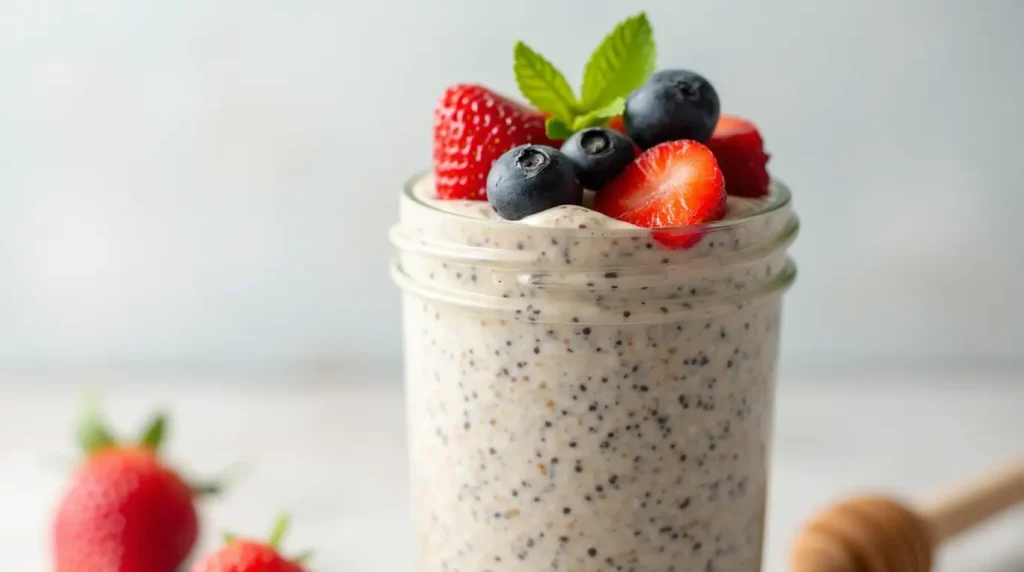
Storing Tips for the Recipe
Proper storage ensures your chia pudding maintains optimal freshness, texture, and nutritional value:
Refrigerator Storage: Prepared chia pudding keeps perfectly in the refrigerator for up to 5 days when stored in airtight containers. Glass containers work best as they don’t absorb odors and maintain flavor integrity. Individual portion containers make grab-and-go breakfasts effortless.
Meal Prep Strategy: Prepare a large batch on Sunday evening, dividing into individual servings for the work week. This approach saves time and ensures consistent nutrition throughout busy mornings.
Freezer Storage: While not recommended for best texture, chia pudding can be frozen for up to 1 month. Thaw overnight in the refrigerator and stir well before serving. Texture may be slightly less creamy but nutrition remains intact.
Topping Storage: Store fresh fruit toppings separately to prevent soggy textures. Add nuts, seeds, and fresh elements just before serving to maintain crispness and visual appeal.
Signs of Spoilage: Fresh chia pudding should smell neutral with a slight vanilla scent from flavoring. Discard if you notice sour odors, unusual textures, or any signs of mold. The high fiber content makes chia pudding fairly shelf-stable, but always prioritize food safety.
Conclusion
Chia pudding with almond milk represents the perfect intersection of convenience, nutrition, and deliciousness in your morning routine. This ultimate breakfast idea transforms simple ingredients into a satisfying meal that provides sustained energy, essential nutrients, and endless customization possibilities. With its impressive 11 grams of fiber, complete protein profile, and heart-healthy omega-3 fatty acids, this recipe delivers nutritional density that surpasses traditional breakfast options while requiring minimal preparation time.
The beauty of this recipe lies in its adaptability – whether you’re following a specific dietary plan, managing time constraints, or simply seeking a delicious way to start your day, chia pudding meets you where you are. From basic vanilla to exotic tropical variations, the possibilities are limited only by your imagination.
Ready to transform your mornings? Try this recipe tonight and wake up to breakfast perfection. Share your favorite topping combinations in the comments below, and don’t forget to explore our collection of healthy breakfast recipes for more morning inspiration. Your taste buds and your body will thank you for making this nutritious switch.
FAQs
Q: How long does chia pudding need to set before it’s ready to eat? A: Chia pudding reaches optimal texture after 4 hours of refrigeration, though overnight (8+ hours) produces the creamiest consistency. For quicker results, let it sit at room temperature for 30 minutes before refrigerating to jumpstart the gel formation process.
Q: Can I make chia pudding without almond milk? A: Absolutely! Any plant-based milk works beautifully – oat milk creates extra creaminess, coconut milk adds tropical richness, and soy milk provides additional protein. Even regular dairy milk works if that’s your preference.
Q: Why is my chia pudding runny instead of thick? A: Runny consistency usually results from insufficient setting time or too much liquid. Ensure you’re using the correct 4:1 ratio (1 cup liquid to 1/4 cup seeds) and allow adequate time for the seeds to absorb the liquid and swell.
Q: Is chia pudding suitable for weight loss? A: Yes! The high fiber and protein content promote satiety, helping you feel full longer and potentially reducing overall calorie intake. The slow-digesting carbohydrates provide steady energy without blood sugar spikes that can trigger cravings.
Q: Can children eat chia pudding safely? A: Chia pudding is generally safe for children over 12 months old. Start with smaller portions and ensure adequate liquid intake, as the high fiber content requires proper hydration. The naturally sweet flavor and pudding texture make it appealing to young palates.
Q: How do I prevent chia seeds from getting stuck in my teeth? A: Blend half the mixture before adding remaining whole seeds for a smoother texture, or try soaking seeds in liquid for 10 minutes before mixing to soften them. Drinking water after eating and using a straw can also help.
Q: Can I heat chia pudding or must it be served cold? A: While traditionally served cold, you can gently warm chia pudding in the microwave for 30-60 seconds or on the stovetop over low heat. Add a splash of milk if the texture becomes too thick when heated. Warm chia pudding offers comfort food appeal during colder months.

